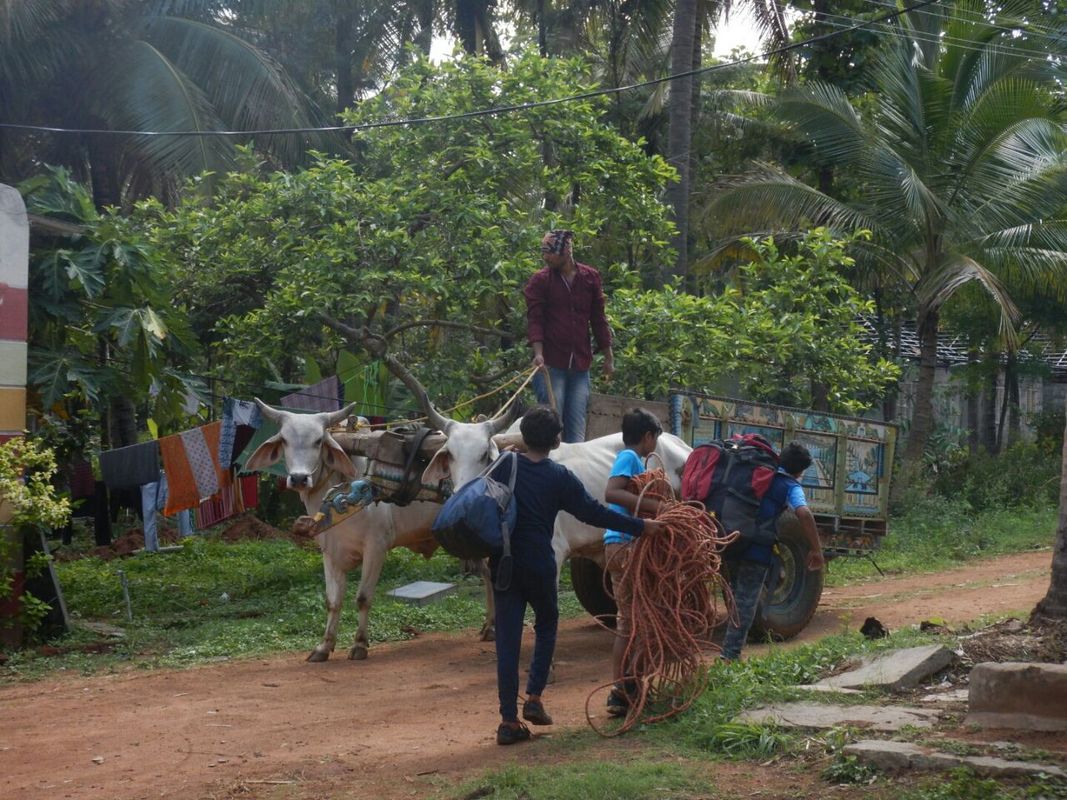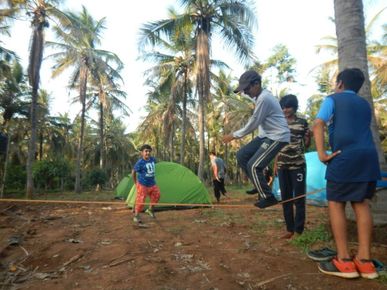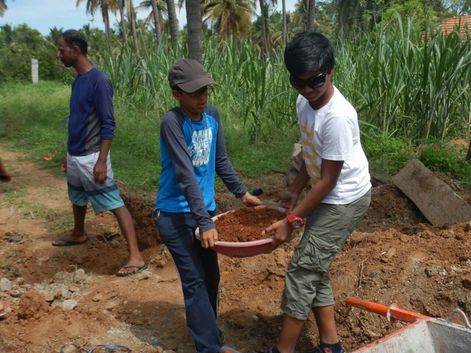Outdoor Experiences for Children Where Nature Where? In this heavily networked and connected world, we have lost touch with ourselves. There is so much emphasis on socializing but the feeling of isolation and loneliness hovers in all us. We are living in a paradoxical world with conflicting needs and actions taken to fulfill those needs. What has also changed drastically is “organicness” in us and our choices and we are passing on this epidemic to our children. Can spending time in the outdoors slow down or reverse this change? Can outdoors restore organic nature in our lives especially our children? If yes, Where is nature? Where is nature? Where is outdoors? How and when do we expose children to the outdoors? When I look outside of my window, I mostly see apartments and flats and gated communities. I see some green cover that is mostly there for decorative purposes. Mostly, cemented or tar roads; no uneven paths with grass and puddles. Where will children run freely with traffic, vehicles and strangers on roads? What if my child touches something or eats something that will cause a cold, an allergy or an infection? How can I make sure my child is safe? Where and how do I start? What are the available accesses to nature and outdoors? How do we create more accessibility to outdoor play spaces? The crux of this article is to explore doors and windows that lead children to the world of outdoors. Play grounds Playgrounds are cradles of spontaneous, unstructured play. Generally, playgrounds are a part of educational institutions and housing complexes with wide open spaces and some play equipments such as swings, slides and monkey bars. They are also used for structured play. Play ground setting touches all areas of child development especially motor development, body coordination and balance, imagination and creativity. Spontaneous play encourages children to think quickly and be open to uncertainty. Free play nurtures interpersonal skills, trust building and communication. Thus, spending time in the play grounds is time invested in well being. Gardens and Farms Gardening and farming is a sensory experience for children. They touch and feel the soil and life, seeds and flowers, see the vibrant colors and varied sizes of the plants, insects and birds, can hear birds and insects and smell the amazing scents of the flowers and mud. Children climbing trees, laying with leaves and twigs, digging soil and planting is a holistic experience in itself. They are introduced to life processes and they are part of something coming to life. They learn to nurture and qualities of planning, patience and hard work. Gardening and farming teaches children take responsibility and environmental significance. Children who spend time with plants are seen to be more instinctive and intuitive. Spending time in the farms and gardens can be a sublime experience. Local Parks Local parks are good contacts for children with nature. Grass beds with bordering trees and bushy plants are soothing to the eyes and spirit. Pavements for walking and strolling are a breather for children and people of all age groups. Parks provide spaces to play, make friends, enjoy, relax and unwind. The cool breeze and chirping birds teamed with conversations and laughter is a seemingly ideal way to spend every day evenings. Visiting local parks regularly can provide children spaces to free play, foster their physical, mental and emotional health. It is also a place to meet new children and also people of varied ages and backgrounds and play or engage with them in different ways. National parks and Zoos National Parks and Zoos makes it feasible to witness wildlife which otherwise cannot be seen, usually especially wild animals. All animals are usually caged or placed in restricted and artificially created environments that mimic their natural ones. Children can see these animals in reality which otherwise would have been in their natural habitats, wild and free. National parks and zoos might ignite enthusiasm and awe towards animals resulting in a surge of excitement in children. Personally this is something I am not in agreement with. Caging animals however conducive it might be, impedes the animal in many ways. A child watching these animals in this manner paints a false picture of the animal and wildlife might be reduced to a mere entertainment affair. Nonetheless, an enjoyable experience for children. Forests and wildlife sanctuaries Trails, safaris and jungle stays are a substantive experience of nature. Forests ecology with trees, plants, mosses, creepers and ferns with wild animals, birds and insects is an experience. Unaltered with woody roots, creaky branches, crunching path can fill us with wonder and unruffle us at the same time. The sounds of chirping birds and croaking frogs and crickets and cicadas can put us in state of tranquility. Forests teach us so much and alter us completely. The forests have something for each one of us especially, children. As rightly said – “Once you enter the forest, you never return the same” Besides that, the purpose of visiting the forest and the people with whom we share our time and experience counts. Free play is not a feasible in the forests or sanctuaries. The possibility of children visiting the forests solely depends on the parents and adult’s affinity towards wildlife. If the parents are fearful or hesitant towards wilderness there are very little chances that the child would visit a forest. A naturalist or a person who is familiar and has some knowledge about the wildlife and ecology can deepen our learning experience in the forests and wildlife sanctuaries. Therefore, forests though enriching for children, the probabilities of accessing it is lean.  Treks and trails Trekking and hiking is a transforming experience of children and adults. The wooded heaven, the beaten elevated trails, unexpected spotting of birds and animals can fill us with humility. Trekking with minimal resources and challenging themselves to push and adjust to adversities can shape them as independent and resilient individuals. Children develop leadership qualities, boast their confidence and self image and learn endurance. Children and adults who trek together deepen their relationships with each other. They also learn to respect and value nature. They tend to be more sensitive to themselves and others including plants and animals. They learn life lessons through direct experience and reflection. Physical and mental health is an inevitable consequence of trekking. Children become more aware and well-informed about geography, environmental science or wildlife. Treks can be easily considered as a one stop solution for life. Summer camps In the past few months, how many fliers do you come across in a day that announces “Summer camps”? Art to Robotics, Baking to Storytelling; Crafts to Culture, so many of them. They are there everywhere, social media, newspapers and Whatsapp groups. Some stand out and are offbeat and some seem like they are all the same. One of the offbeat summer camps would be Outdoor and Adventure summer camp. What are these outdoor and adventure summer camps? Why would I want to send my children to O&A camp and not a robotics camp? Why climb trees and do cave man things when technology is the thing, right?! If these are your questions and dilemmas then the next article is the answer for you. We will explore the benefits of sending your children to an Outdoor and Adventure summer camp. We will see how these O&A camps can instill love for nature and belongingness in the outdoors in children and also avail to its insurmountable benefits of nature. References https://www.theatlantic.com/education/archive/2016/09/kindergarten-naturally/500138/ https://www.forestschooltraining.co.uk/forest-school/the-benefits/ https://livingwellmom.com/2017/04/benefits-taking-kids-hiking/ https://indiahikes.com/trekking-changes-children/ https://indiahikes.com/why-should-you-encourage-your-child-to-hike/ http://mommyuniversitynj.com/2015/05/04/10-benefits-of-gardening-with-kids/ http://www.rasmussen.edu/degrees/education/blog/gardening-for-kids-benefits/ https://www.betterhealth.vic.gov.au/health/healthyliving/gardening-for-children https://www.aaastateofplay.com/the-benefits-of-playgrounds-on-child-development/ https://www.psychologytoday.com/us/blog/freedom-learn/201206/free-play-is-essential-normal-emotional-development http://www.momsteam.com/successful-parenting/unstructured-free-play-important-for-child-development-experts-say Ashwini GovindOutlife Experiential Education
0 Comments
|
Archives
July 2024
Categories
All
|
- Home
-
Corporate
-
Team Building
>
- Team Building Activities
- Corporate Team Bonding
- Fun Team Outing
- Quotes on Teamwork
- In office Team Building Activities
- 5C Key Elements for Team Building
- Special Team Building >
- Virtual Team Building
- Top 10 Team Building Activities
- Team Building Bangalore
- Team Building Hyderabad
- Team Building Interventions
- Outbound Training >
- Leadership Programs >
- Team Outing >
- Employee Engagement >
- Behavioral Skills >
- Team Development >
- Corporate Adventure >
-
Team Building
>
- Schools
- Individuals
- Clients
- Gallery
- About us
- Articles
- Blog
- Experiential Leadership Training
- Strategic Leadership Training
- Home
-
Corporate
-
Team Building
>
- Team Building Activities
- Corporate Team Bonding
- Fun Team Outing
- Quotes on Teamwork
- In office Team Building Activities
- 5C Key Elements for Team Building
- Special Team Building >
- Virtual Team Building
- Top 10 Team Building Activities
- Team Building Bangalore
- Team Building Hyderabad
- Team Building Interventions
- Outbound Training >
- Leadership Programs >
- Team Outing >
- Employee Engagement >
- Behavioral Skills >
- Team Development >
- Corporate Adventure >
-
Team Building
>
- Schools
- Individuals
- Clients
- Gallery
- About us
- Articles
- Blog
- Experiential Leadership Training
- Strategic Leadership Training
Our Programs
OUR TRAINING DELIVERY LOCATIONS:
Ahmedabad, Bangalore, Chennai, Kolkata, Delhi, Goa, Hyderabad, Mumbai, Pune, Vizag - India
Ahmedabad, Bangalore, Chennai, Kolkata, Delhi, Goa, Hyderabad, Mumbai, Pune, Vizag - India


 RSS Feed
RSS Feed
